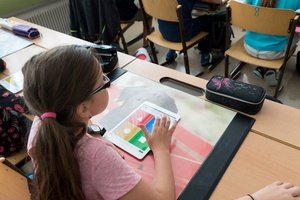This repetition comes down to the desire to master a skill. These skills are transferable to many physical pursuits and also bring many wellbeing benefits.
Why else do they do it? According to Lockwood and O’Connor (2016), play involves being “active, joyful and meaningful”. Imagine if this could translate to academia?
Most play-based studies involve either adults or young children.
Between these two age groups are high school students, a group increasingly differentiated in their development.
Research on play-based learning is largely confined to sport and gaming in primary and preschool education, but there is an increasing movement toward play-based learning for academics, which is mostly centred on both the hard and soft skills that are transferable.
‘Pleasure, curiosity and creativity’ are three words that rarely come to the reflective mind of a high school student. Yet all three are likely to have been present in our greatest learning moments.
Even now, I experience those sensations learning creative writing and golf. High school students pursue gaming, sport and music skills with great vigour, often to the dismay of parents and educators. Why? Because in at least one way these are active, curious, creative, pleasurable, joyful, or meaningful.
Studies from the University of Genoa reveal that the use of ‘Digital Serious Games’ as a learning tool for adults is leading to advances in formal academic learning. Even more rewarding for classroom teachers is “the evidence of persistence” that is shown to increase through games.
These studies were based on adults and designed to foster a nostalgic and rewarding return to learning that many had not participated in since school.
Our high school students are present in that same stage that these tests were designed to replicate, indicating a likelihood of potential gains.
As a long-time participant in adult education, I have experienced and witnessed varying levels of engagement in learning, as both an educator and student. Adults subjected to professional development show similar patterns of disengagement to teenage students.
As a teacher, I have been subjected to professional development which lacked considered engagement and pedagogy due to an expectation that my professionalism and commitment would simply allow for effective learning.
I have experienced similar levels of ineffective professional development as a NSW Police Officer – with the exception of play-based learning.
The most effective teaching instruction I have received was in the ‘mock battle’ of a paintball game of Simunition (simulated ammunition).
This experience allowed the active, curious, creative, pleasurable, joyful, or meaningful experience – that is easily recalled 22 years later – as we worked individually and in teams, searching and clearing rooms and challenging suspects and civilians. It combined years of academically and physically transferable skills.
What if we applied this same framework to high school learning?
At present there is a noticeable void between early childhood education and adult education, at a time when students face the duality of their greatest expectational pressure combined with physical and emotional growth.
The teenage years can highlight the struggle between childhood and adulthood, as progression of Piaget and Vygotsky's ‘stages of development’ are often inconsistent. The need for differentiating learning has never been so high, or so expected.
Play-based learning is adaptable, familiar and with inferential contexts which allow for differentiation across stages of development.
It is a movement from ‘free-based’ child play to a facilitated approach providing the development of soft and hard transferable skills.
Inquiries are developed through a return to questioning the world around them. Note the aforementioned ‘curious’ element, often stifled in high school by the pressures of conformity and compliance with peer expectations.
With play-based games, there's no longer on a singular correct answer.
In short, I want questions, not answers...
It is my aim to encourage high school educators to experiment and contribute to the collection of data, testing play-based learning in practical application. I have worked closely with project-based learning over the past few years and am a strong advocate.
Play-based learning has similar tenets, as does Deep Learning pedagogy and the ‘6 C’s of Deeper Learning’. But what sounds more fun? What will drive your high school students to your elective? What will have them relaxed and engaged to the point of genuine, unforced, learning? What approach will educators have more engagement and creativity with?
Look at your PDHPE department with the hybrid games they design. Cross genre, cross code and inherently fun. What was the last ‘hybrid’ lesson you used in your class for greater effect?
Experiential learning and play-based learning are models to engage students but also provide the structure to build upon with reflection and Socratic-style questioning.
Genuine learning comes when we ask questions. It is more important to ask questions, the right questions, and expand our thinking. It is limitless; can the kid on the basketball court give a definitive, one-word answer to the question: 'Will you play NBA?'
No, but can he ask questions, hold discussions, overcome obstacles and create solutions about Allen Iverson and his height, The Bulls domination, Jordan’s hangtime, Phil Jackson’s coaching principals, three-pointer statistics and percentage plays, the college system, draft opportunities, Euro leagues and NBL feeder opportunities.
Each topic raises more nuanced and specialised questions around what is an increasingly complex game. Each raises more opportunities to gain knowledge, display knowledge and find solutions to problems.
In the classroom I have looked at ways of developing this same method of learning. You can teach geography and science topics with 'Can you survive a Tsunami?' Students test escape plans with topographic maps, Google Street View and altitude GPS apps before driving to each location and assessing their plan in-situ.
Every plan and every response leads to another decision, another variable. Those who stole a car faced legal consideration if they survived – and they learned of the judicial process.
They learned that a panicking community will quickly constrict a road. They assess distance and time, survival skills, the risk and reward of alienating family members and colleagues.
They learn from each other, question each other, whilst never actually realising they have ticked curriculum boxes across multiple KLA’s.
By the way, they had fun all the way through it, and being allowed to use a mobile phone responsibly in school without it being ‘yondred’ was a winner.
In the realm of English, I have developed Crime Story, drawing upon my previous career as a detective, a Master of Arts (Writing) and my teaching degree to create an engaging way of learning writing skills.
The series of crimes students investigate lead to so many more theories than I ever thought possible. Every option is valid, and every student is validated as they develop deeper learning, linking observations to inferences and testing valid hypotheses.
This is transferred through lexical chaining, cumulation, sensory imagery, procedural narrative frames and authentic dialogue with some ‘secret sauce’ proprietary techniques. They brush for prints, swab for DNA, run ballistics and undertake the full gamete of investigations with genuine equipment.
Motive, opportunity, ability; the essential components for a crime are discussed Socratic-style, in what is a better way to learn.
I am rarely amazed anymore, however the high school students of today are amazing. Many lag against the benchmarks of PAT and NAPLAN. Many are maligned by previous generations who extol the virtues of their simpler education and the reliance on the three “R’s” – which is phonetically and grammatically paradoxical.
Today’s world is not simple. If it was, teaching would be easy and shortages would not exist. So what I am excited by is the differences in knowledge they have, and the opportunities that come when we both work together.
In my field I have students with (nearly!) as much knowledge and theories about crime investigation as I have, built on years of exposure to multi-media. I only had books. I had some TV but my conservative parents never allowed Hill Street Blues.
Students now avail themselves willingly to long-form TV procedurals with well-written narrative and digital games with comprehensive, layered role player narratives and a glut of true crime podcasts and web-based media.
I see Crime Story as a small step to bridge this divide between the written word and multi-media. I cherish the opportunity to capitalise on what they use and enjoy. I cherish the opportunity to change their perceptions from being consumers to producers of this new world.
My challenge to you is simple: what are you doing in the classroom?
Share it with me, share it with your staff, your school, your community and collegial network.
I am looking for evidence to support my studies that play-based learning and experiential learning works in high school. My advice is also simple: just try.
It will never be the same lesson twice, I can guarantee that.














